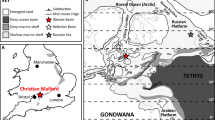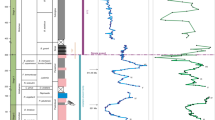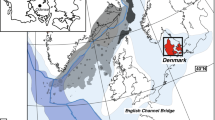Abstract
The Eocene/Oligocene boundary, at about 33.7 Myr ago, marks one of the largest extinctions of marine invertebrates in the Cenozoic period1. For example, turnover of mollusc species in the US Gulf coastal plain was over 90% at this time2,3. A temperature change across this boundary—from warm Eocene climates to cooler conditions in the Oligocene—has been suggested as a cause of this extinction event4, but climate reconstructions have not provided support for this hypothesis. Here we report stable oxygen isotope measurements of aragonite in fish otoliths—ear stones—collected across the Eocene/Oligocene boundary. Palaeotemperatures reconstructed from mean otolith oxygen isotope values show little change through this interval, in agreement with previous studies5,6. From incremental microsampling of otoliths, however, we can resolve the seasonal variation in temperature, recorded as the otoliths continue to accrete new material over the life of the fish. These seasonal data suggest that winters became about 4 °C colder across the Eocene/Oligocene boundary. We suggest that temperature variability, rather than change in mean annual temperature, helped to cause faunal turnover during this transition.
This is a preview of subscription content, access via your institution
Access options
Subscribe to this journal
Receive 51 print issues and online access
$199.00 per year
only $3.90 per issue
Buy this article
- Purchase on Springer Link
- Instant access to full article PDF
Prices may be subject to local taxes which are calculated during checkout



Similar content being viewed by others
References
Raup, D. M. & Sepkoski, J. J. Periodic extinction of families and genera. Science 231, 833– 836 (1986).
Dockery, D. T. Punctuated succession of Paleogene mollusks in the Northern Gulf Coastal Plain. Palaios 1, 582–589 (1986).
Haasl, D. M. & Hansen, T. A. Timing of latest Eocene molluscan extinction patterns in Mississippi. Palaios 11, 487–494 (1996).
Hansen, T. A. Extinction of Late Eocene to Oligocene molluscs: Relationship to shelf area, temperature changes, and impact events. Palaios 2, 69–75 (1987).
Zachos, J. C., Stott, L. D. & Lohmann, K. C. Evolution of early Cenozoic marine temperatures. Paleoceanography 9, 353– 387 (1994).
Oboh, F. E., Jaramillo, C. A. & Reeves-Morris, L. M. Late Eocene-Early Oligocene paleofloristic patterns in southern Mississippi and Alabama, US Gulf Coast. Rev. Palaeobot. Palynol. 91, 23–34 (1996).
Palmer, K. V. W. & Brann, D. C. Catalogue of the Paleocene and Eocene mollusca of the southern and eastern United States: Part I. Pelecypoda, Amphineura, Pteropoda, Scaphopoda, and Cepholopoda. Bull. Am. Paleontol. 48, 1–443 (1965).
Palmer, K. V. W. & Brann, D. C. Catalogue of the Paleocene and Eocene mollusca of the southern and eastern United States: Part II. Gastropoda. Bull. Am. Paleontol. 48, 471–1027 (1966).
Dockery, D. T. Lower Oligocene Bivalvia of the Vicksburg Group. Mississippi Dept Natural Resour. Bur. Geol. Bull. 123, 1– 261 (1982).
MacNeil, F. S. & Dockery, D. T. Lower Oligocene Gastropoda, Scaphopoda, and Cephalopoda of the Vicksburg Group in Mississippi. Mississippi Dept Natural Resour. Bur. Geol. Bull. 124, 1–415 (1984).
Hansen, T. in Eocene-Oligocene Climatic and Biotic Evolution (eds Prothero, D. R. & Berggren, W. A.) 341–348 (Princeton Univ. Press, Princeton, New Jersey, 1992).
Frederiksen, N. O. Sporomorph biostratigraphy, floral changes, and paleoclimatology, Eocene and Earliest Oligocene of the Eastern Gulf Coast. US Geol. Surv. Prof. Pap. 1448, 1–68 ( 1988).
Seisser, W. G. Paleogene sea levels and climates: U.S.A. Eastern Gulf Coastal Plain. Palaeogeogr. Palaeoclimatol. Palaeoecol. 47, 261– 275 (1984).
Kalish, J. M. 13C and 18O isotopic disequilibria in fish otoliths: metabolic and kinetic effects. Mar. Ecol. Prog. Ser. 75, 191–203 (1991).
Kalish, J. M. Oxygen and carbon stable isotopes in the otoliths of wild and laboratory-reared Australian salmon (Arripis trutta). Mar. Biol. 110, 37–47 (1991).
Iacumin, P., Bianucci, G. & Longinelli, A. Oxygen and carbon isotopic composition of fish otoliths. Mar. Biol. 113, 537–542 (1992).
Patterson, W. P., Smith, G. R. & Lohmann, K. C. in Climate Change in Continental Isotopic Records (eds Swart, P., Lohmann, K. C., McKenzie, J. & Savin, S.) 191–202 (AGU Monograph 78, American Geophysical Union, Washington DC, 1993).
Valentine, J. W. Evolutionary Paleoecology of the Marine Biosphere (Prentice-Hall, Englewood Cliffs, New Jersey, 1973).
Vermeij, G. J. Biogeography and Adaptation (Harvard Univ. Press, Cambridge, Massachusetts, 1978).
Miller, K. G. in Eocene-Oligocene Climatic and Biotic Evolution (eds Prothero, D. R. & Berggren, W. A.) 160–177 (Princeton Univ. Press, Princeton, New Jersey, 1992).
Zachos, J. C., Breza, J. R. & Wise, S. W. Early Oligocene ice-sheet expansion on Antarctica: Stable isotope and sedimentological evidence from Kerguelen Plateau, southern Indian Ocean. Geology 20, 569– 573 (1992).
Zachos, J. C., Lohmann, K. C., Walker, J. C. G. & Wise, S. W. Abrupt climate change and transient climates during the Paleogene: A marine perspective. J. Geol. 101, 191– 213 (1993).
Lear, C. H., Elderfield, H. & Wilson, P. A. Cenozoic deep-sea temperatures and global ice volumes from Mg/Ca in benthic foraminiferal calcite. Science 287, 269–272 (2000).
Dettman, D. L. & Lohmann, K. C. in Climate Change in Continental Isotopic Records (eds Swart, P. K., Lohmann, K. C., McKenzie, J. & Savin, S.) 153–163 (AGU Monograph 78, American Geophysical Union, Washington DC, 1993).
NOAA/PMEL World Ocean Atlas [online] (cited Nov. 1999) <http://ferret.wrc.noaa.gov/fbin/climate_ server> (1994).
Weidman, C. R., Jones, G. A. & Lohmann, K. C. The long-lived mollusc Arctica islandica: A new paleoceanographic tool for the reconstruction of bottom temperatures for the continental shelves of the Northern Atlantic Ocean. J. Geophys. Res. 99, 18305–18314 (1994).
Grossman, E. L. & Ku, T.-L. Oxygen and carbon isotope fractionation in biogenic aragonite: temperature effects. Chem. Geol. 59, 59–74 ( 1986).
Berggren, W. A., Kent, D. V., Swisher, C. C. I. & Aubry, M.-P. A Revised Cenozoic Geochronology and Chronostratigraphy 129– 212 (Special Publication 54, SEPM, Tulsa, Oklahoma, 1995).
Baum, J. S., Baum, G. R., Thompson, P. R. & Humphrey, J. D. Stable isotopic evidence for relative and eustatic sea-level changes in Eocene to Oligocene carbonates, Baldwin County, Alabama. Geol. Soc. Am. Bull. 106, 824–839 ( 1994).
Yancey, T. E. & Davidoff, A. J. Paleogene Sequence Stratigraphy of the Brazos River Section, Texas (Gulf Coast Association of Geological Societies, Austin, Texas, 1994).
Acknowledgements
We thank C. Wurster, L. Wingate and G. Hourigan for analysing samples and assisting with microsampling, and M. Suchter for assistance in microsampling, data entry and analysis; D. Nolf for providing additional Palaeogene otoliths from the Gulf Coast to augment our available samples; and T. Baumiller, B. Wilkinson, R. Buick and P. Wilf for comments on the manuscript. Ideas presented here benefited from discussion with participants of the GSA Penrose Conference on the Eocene/Oligocene boundary held in August 1999. This work was supported by the Michigan Society of Fellows and the NSF.
Author information
Authors and Affiliations
Corresponding author
Rights and permissions
About this article
Cite this article
Ivany, L., Patterson, W. & Lohmann, K. Cooler winters as a possible cause of mass extinctions at the Eocene/Oligocene boundary. Nature 407, 887–890 (2000). https://doi.org/10.1038/35038044
Received:
Accepted:
Issue Date:
DOI: https://doi.org/10.1038/35038044
This article is cited by
-
The first cetacean from the early Oligocene of the SW German Mainz Basin: a probable cheek tooth of a mysticete (Mammalia: Cetacea)
PalZ (2024)
-
A punctuated equilibrium analysis of the climate evolution of cenozoic exhibits a hierarchy of abrupt transitions
Scientific Reports (2023)
-
Seasonal climatic instability in the western Chinese Loess Plateau during Marine Isotope Stages 12–10
Scientific Reports (2023)
-
Combining palaeontological and neontological data shows a delayed diversification burst of carcharhiniform sharks likely mediated by environmental change
Scientific Reports (2022)
-
Mitogenome analyses elucidate the evolutionary relationships of a probable Eocene wet tropics relic in the xerophilic lizard genus Acanthodactylus
Scientific Reports (2021)
Comments
By submitting a comment you agree to abide by our Terms and Community Guidelines. If you find something abusive or that does not comply with our terms or guidelines please flag it as inappropriate.



